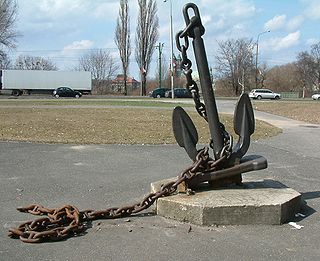This page is based on this
Wikipedia article Text is available under the
CC BY-SA 4.0 license; additional terms may apply.
Images, videos and audio are available under their respective licenses.

The bowline is an ancient and simple knot used to form a fixed "eye" at the end of a rope. It has the virtues of being both easy to tie and untie; most notably, it is easy to untie after being subjected to a load. The bowline is sometimes referred to as King of the knots because of its importance. Along with the sheet bend and the clove hitch, the bowline is often considered one of the most essential knots.

A shank is a type of knot that is used to shorten a rope or take up slack, such as the sheepshank. The sheepshank knot is not stable. It will fall apart under too much load or too little load.
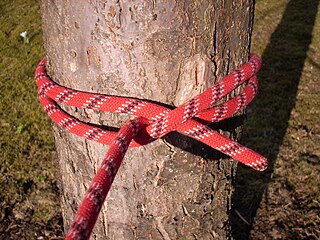
The clove hitch is a type of knot. Along with the bowline and the sheet bend, it is often considered one of the most important knots and is commonly referred to as a Double Hitch. A clove hitch is two successive half-hitches around an object. It is most effectively used as a crossing knot. It can be used as a binding knot, but is not particularly secure in that role. A clove hitch made around the rope's own standing part is known as either two half-hitches or buntline hitch, depending on whether the turns of the clove hitch progress away from or towards the hitched object.
Although the name clove hitch is given by Falconer in his Dictionary of 1769, the knot is much older, having been tied in ratlines at least as early as the first quarter of the sixteenth century. This is shown in early sculpture and paintings. A round turn is taken with the ratline and then a hitch is added below. The forward end is always the first to be made fast.
The difference between two half hitches and the clove hitch is that the former, after a single turn around a spar, is made fast around its own standing part, while the latter is tied directly around the spar.
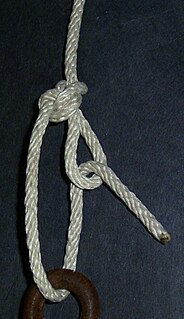
The trucker's hitch is a compound knot commonly used for securing loads on trucks or trailers. This general arrangement, using loops and turns in the rope itself to form a crude block and tackle, has long been used to tension lines and is known by multiple names. Knot author Geoffrey Budworth claims the knot can be traced back to the days when carters and hawkers used horse-drawn conveyances to move their wares from place to place.

The marlinespike hitch is a temporary knot used to attach a rod to a rope in order to form a handle. This allows more tension than could be produced comfortably by gripping the rope with the hands alone. It is useful when tightening knots and for other purposes in ropework.

The water bowline is a type of knot designed for use in wet conditions where other knots may slip or jam.

The taut-line hitch is an adjustable loop knot for use on lines under tension. It is useful when the length of a line will need to be periodically adjusted in order to maintain tension. It is made by tying a rolling hitch around the standing part after passing around an anchor object. Tension is maintained by sliding the hitch to adjust size of the loop, thus changing the effective length of the standing part without retying the knot.

The timber hitch is a knot used to attach a single length of rope to a cylindrical object. Secure while tension is maintained, it is easily untied even after heavy loading.

A Zeppelin bend is a general-purpose bend knot. It is a secure, easily tied, and jam-resistant way to connect two ropes. Though its simplicity and security may be matched by other bends, it is unique in the ease with which it is untied, even after heavy loading, by pulling the opposing bridges away from each other.

The sheet bend is a bend. It is practical for joining lines of different diameter or rigidity.
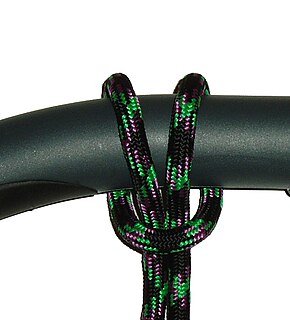
The cow hitch is a hitch knot used to attach a rope to an object. The cow hitch comprises a pair of half-hitches tied in opposing directions, as compared to the clove hitch in which the half-hitches are tied in the same direction. It has several variations and is known under a variety of names. It can be tied either with the end of the rope or with a bight.

The buntline hitch is a knot used for attaching a rope to an object. It is formed by passing the working end around an object, then making a clove hitch around the rope's standing part, taking care that the turns of the clove hitch progress towards the object rather than away from it. Secure and easily tied, the buntline hitch will jam when subjected to extreme loads. Given the knot's propensity to jam, it is often made in slipped form.
The buntline hitch, when bent to a yard, makes a more secure knot than two half hitches, but is more liable to jam. It differs from two half hitches in that the second half hitch is inside instead of outside the first one.

The rolling hitch is a knot used to attach a rope to a rod, pole, or another rope. A simple friction hitch, it is used for lengthwise pull along an object rather than at right angles. The rolling hitch is designed to resist lengthwise movement for only a single direction of pull.
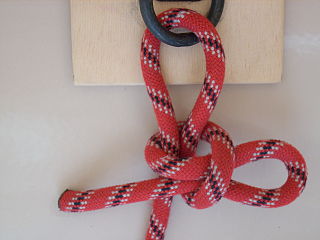
The halter hitch is a type of knot used to connect a rope to an object. As the name implies, an animal's lead rope, attached to its halter, may be tied to a post or hitching rail with this knot. The benefit of the halter hitch is that it can be easily released by pulling on one end of the rope, even if it is under tension. Some sources show the knot being finished with the free end running through the slipped loop to prevent it from working loose or being untied by a clever animal, still allowing easy but not instant untying.

The two half-hitches is a type of knot, specifically a binding knot or hitch knot. It consists of an overhand knot tied around a post, followed by a half-hitch. Equivalently, it consists of a half-turn around a post followed by a clove hitch of the running end around the standing part.

The highpoint hitch is a type of knot used to attach a rope to an object. The main feature of the hitch is that it is very secure, yet if tied as a slipped knot it can be released quickly and easily with one pull, even after heavy loading. The highpoint hitch is a buntline hitch with an extra half turn, making it more secure.

The tumble hitch is a quick-release draw loop knot used for temporarily securing a rope such that it can be released easily and cleanly. The hitch can be untied with a tug of the working end, even when under tension. The tumble hitch is tied on the bight, but near the working end.



